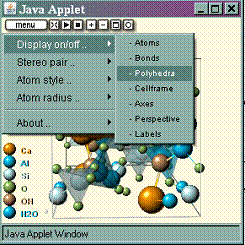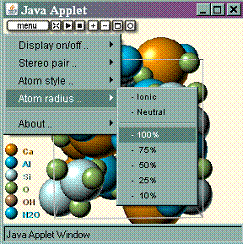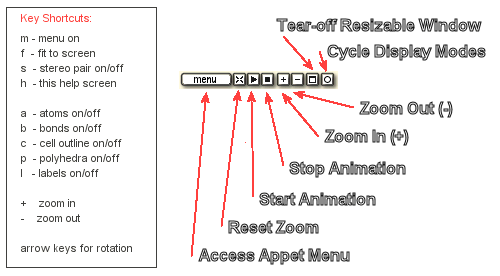|
To use the jPOWD applet, your browser must have the JAVA Virtual
Machine (JVM) enabled. The jpowdjpx.jar MDI, Inc. is a web browser JAVA applet
that can be integrated into web pages and uses .jpx files from jPOWD program for
viewing crystallographic structure data in .jpx format.
jPOWD Applet
|
Click on mineral name in the
Index of Mineral Structures for a large interactive display
(jpowdjpx.jar Applet) of the chemical structure. This applet requires Java and
Specifically the SUN Java Virtual Machine
installed/enabled on the client browser. If you have Java installed but no
crystal structure appears in the window on the left, you probably have the
obsolete MicroSoft Java Virtual Machine installed on your computer. See
www.java.com for the proper Java plug-in required to view the interactive
structural data. Follow this link for a
discussion on mineral structures.
|
Warning: This applet runs in your browser (client side
application) and is very compute intensive. It may not run on older computers.
What's New
Major new addition to Webmineral. View interactive
crystal structure diagrams using
jPOWD Applet. This applet is replacing the
jMOL applet
because it is smaller in size and it specializes in mineral and material
structure files. The structure files are now integrated-with and viewable-by the
species pages for each mineral that has published structural data.
jPOWD from Materials Data, Inc. generates x-ray pattern and structure
simulation 'by reading crystallographic structure files, such as *.cif and
generates a simulated x-ray diffraction pattern from the atomic positions. The
output of binary crystal files (*.jpx) from the jPOWD program and the jpowdjpx
applet allows web display of crystal structures.
Mineral Structures - Thanks for the tireless efforts of Dr Robert Downs and
his associates at the University of Arizona for their
crystal structure
database. This database contains every structure ever published in the
American Mineralogist, The Canadian Mineralogist, European Journal of Mineralogy
and Physics and Chemistry of Minerals as well as other selected journals. These
structure files contain over 14,000 entries. All of them have been downloaded
from the
American Mineralogist Crystal Structure Database,
converted to .jpx files, and uploaded to webmineral.com.
Frequently Asked Questions (FAQ)
Q: When visualizing molecules containing oxygen,
the spheres representing oxygen are tiny compared to the other elements like silicon or magnesium.
-
A: Most mineralogists use cation positions to identify and
classify structures in minerals.
The jPOWD applet display shows atoms much smaller than the real radius so that
this structure can be visualized. The default radius used by jPOWD is 30%.
To change
the default atomic radii, just use the menu functions in the applet.
| First, turn off any polyhedra: |
Second, to view full sized atoms
use the menu to pick atom size 100% |

|
 |
Q: The perspective picture gives polyhedra which are not relevant to the structure.
-
A: The jPOWD program has a batch converter which allows the creation of .jpx files.
With over 14,000 structure files available from the American Mineralogist Crystal Structure Database,
the batch process uses program settings which may not be optimal for all crystal structure files.
Some of the resulting .jpx files may be incorrectly formatted because of ambiguities in the source .cif
files. In all cases the original references are provided to verify the crystal structures.
If you need publication-quality displays I would suggest you get a copy of jPOWD.
That way you could tweak the display to your liking on an individual basis.
Contact them at materialsdata.com.
Q: The jpowdjpx.jar applet fails to materialize in a browser window. Here is a
list of items to check:
-
- Sometimes a refresh of the web browser window will re-initialize
jpowdjpx.jar applet.
- Try clearing the browser cache and restarting the browser.
- Try a different brand of web browser (always use an up-to-date version).
- Check the JAVA Virtual Machine version. It must be from SUN (www.java.com)
and it should be newer than version 1.0 (jpowdjpx.jar applet was checked on
version 1.5.0_06).
- Be sure the computer has sufficient memory available. The jpowdjpx.jar
applet may not be able to run on computer with minimum memory. Try running
the page on another computer.
- If jpowdjpx.jar will not initialize on a particular structure file but
works on other structure files then it is possible that the .jpx file is
malformed. In this case your only remedy would be to contact me at
.
Applet Instructions
Help file image instructions for jpowdjpx.jar.
There are some caveats to mention. These are:
- Structure files from the American Mineralogist Crystal Structure
Database contains data for synthetic minerals as well as data for
non-mineral materials. Many of the crystal studies were done for temperature
and pressure effects. In all cases, the original reference should be consulted
for details.
- The level of programming involved in the use of jpowdjpx.jar requires the
latest version of the SUN Java Virtual Machine. Older versions of JAVA
may not or will not work. In addition, older versions of web browsers may show
quirks in the display of the structure applet. It is recommended to use the
latest version of web browser.
Copyright Considerations
All binary crystal structure files (.jpx) on this website are the property of
Webmineral.com. The applet used for the web display of those structure files
(jpowdjpx.jar) is copyrighted by
Materials Data, Inc
and is used with permission on webmineral.com.
In keeping with the "fair use" copyright doctrine, webmineral will allow the
reproduction of a limited number of .jpx files from this website for educational
use as long as credit is given to webmineral.com as the source of the .jpx files
and credit is given to Materials Data, Inc. for the jpowdjpx.jar file.
Any other use (no citation given, large numbers of files being reproduced,
commercial work, etc.) will be considered an infringement of copyright if prior
arrangements have not been made with webmineral.com or Materials Data, Inc.
Other References to Mineral Structures
American Mineralogist
Crystal Structure Database
jPOWD - Materials Data, Inc.
WWW-MINCRYST -
Russian Federation of Basic Research
IUCr - Crystallographic
Information File
RCSB PDB - Protein Data Bank
CCDC - Cambridge Crystallographic Data
Centre
Search the Mineralogy Database
Search the Web
|
|

